Indian Ocean Earthquake and
Update; Thursday 10/1/09
PADANG, Indonesia – Rescue workers used excavators Thursday to pull out victims, some screaming in pain, from the heavy rubble of buildings felled by a powerful earthquake that killed at least 531 people. The death toll was expected to rise.
The brunt of Wednesday's 7.6-magnitude earthquake, which originated in the sea off Sumatra island, appeared to have been borne by Padang town where 376 people were killed. Four other districts accounted for the remaining deaths.
The region was jolted by another powerful earthquake Thursday morning, causing damage but no reported fatalities.
More than 500 buildings including hotels, schools, hospitals and a mall were destroyed or damaged in Padang. Thousands of people were believed to be trapped in the rubble.
https://news.yahoo.com/s/ap/20091001/ap_on_re_as/as_indonesia_earthquake
Tsunami occurred on 12/26/04.
7.6 Indonesian quake kills dozens, traps thousands Â
PhysOrg - September 30, 2009 Â


 Â 8.0 Quake triggers 3 tsunamis in the Samoas, killing 99
 8.0 Quake triggers 3 tsunamis in the Samoas, killing 99AP - September 30, 2009 Â

The latest underwater earthquake and tsunami had a magnitude somewhere
between 8.0 and 8.3. No more lectures from me on the where this is all
going as the time between earthquakes decreases, and their intensity
increases, exponentially. As you and I follow the accelerating Earth
changes, you know the tectonic plates are cracked globally (especially under Mexico City), solar max begins in 2010, we live in the Age of Prophecy,
we are here to witness closure and go home, and most paradigms within
the dynamics of this program are collapsing.Â
IRIS Earthquake Monitor USGS
Twilight Zone .. celebrating its 50th anniversary in 2009.
October 2009 - 50 years later, Twilight Zone bridges time Â
AP - September 29, 2009
Â
SETI: 50 Years Later
It is impossible to believe that after 50 years SETI has not made
contact. Alas ... the true comes out at the end of the story.
SETI, or the Search for
Extra-Terrestrial Intelligence (SETI) is the collective name for a
number of activities people undertake to search for extraterrestrial
life.Seti I was the name of a nineteenth dynasty Egyptian Pharaoh.
Seti: The Hunt for ET Â Independent - September 29, 2009
SETI at 50: 10 key moments in the search for extraterrestrial life  Telegraph.co.uk - September 29, 2009
The Search for Extraterrestrial Intelligence, or SETI, is 50
years old this month. We look at 10 memorable events in the search for
life on other planets. SETI was founded in response to a September 1959 Nature journal article, Searching for Interstellar Communication,
which suggested that a systematic search for alien life was worthwhile.
Since then, it has spent 50 years listening to the stars with radio
telescopes, and at times trying to send messages of its own to other
planets. Here are 10 of the most significant events in mankind¹s search
for other life.
Little Green Men: Pulsars

In 1967, astronomers in the UK spotted a radio signal from another
star. Nothing too remarkable in that, as all stars emit radio waves.
What was unexpected, though, was that this one turned itself on and off
with perfect regularity: one 0.04 second pulse every 1.3373 seconds.
The metronomic beat sparked speculation that it might be a signal from
an alien life form, and the signal was given the name LGM-1, standing
for Little Green Men. In fact, the astronomers had discovered a new
type of star  a pulsar. A form of neutron star (an incredibly dense
dead star: one just 12 miles across would weigh more than our Sun),
they rotate at a huge velocity, giving off powerful beams of radiation
as they spin.
Martian Bacteria?
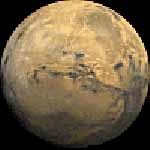
In 1984, a rock was found in the Allan Hills, Antarctica. It is
believed to have been formed on Mars around 4.5 billion years ago,
before being blasted into space by meteorite impacts around 15 million
years ago. It then wandered through space for millions of years, before
crashing into our planet about 11,000 years before the birth of Christ.
An interesting enough history, but the meteorite  known as ALH84001 Â
really made the headlines in 1996. Structures that resembled tiny
fossilised bacteria were found, as were organic molecules, sparking
theories of ancient life on Mars. The excitement grew so great that US
President Bill Clinton made a televised announcement about the find.
Arguments over whether these really are evidence of Martian life, or
whether the sample has become contaminated during its time on Earth,
are still raging today.
Earth-like planets
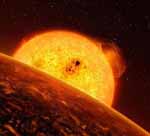
"Terrestrial", or rocky, planets, are considered the most likely
place for life to be found. There are four in our own solar system Â
Mercury, Venus, Earth and Mars. But in the last few years, the first
possible examples of Earth-like planets outside our system have been
found. In 2007 European scientists said they had found two  the third
and fourth planets around the red dwarf Gliese 581 Â which might be habitable.
Water on Mars
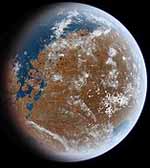
This month the news broke that the Mars Reconnaissance Orbiter has
spotted evidence of ice in five locations on Mars. It is the latest in
a series of discoveries of water on the planet, indicating that the
planet may have had a more humid climate at some stage in the last few
thousand years. Water is required for all known forms of life, so the
existence of water on other planets increases the likelihood that life
exists elsewhere. Mars in the News
Drake Equation
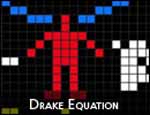
The first serious attempt to quantify the likelihood of humanity coming
into contact with alien life, the Drake equation reads: N=fp ne fl fi
fc L. It states that if we know the rate of star formation, the
percentage of stars that have habitable planets, and the percentage of
those planets that are likely at any given time to support life that
signals its existence to the universe, we could estimate how many
civilizations in our galaxy we might communicate with. Unfortunately,
none of those factors are known, so we are still guessing.
The Arecibo Message

Not part of the search for life per se, but rather helping
anyone else who may be looking for us. In November 1974, a message was
beamed from the Aricebo radio telescope towards the M13 star cluster,
about 25,000 light years away. The message, created by Drake equation
author Frank Drake and physicist Carl Sagan, included an image of a
human and information about the makeup of DNA. Sadly, M13 will have
moved by the time it arrives. A later broadcast - beaming the music of
the Beatles at the Pole Star, 431 light years away - was, in all
apparent seriousness, condemned as inviting an interstellar attack from
warlike aliens.
Voyager
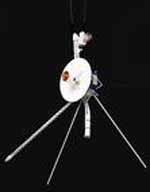
Three years later, in 1977, the two Voyager space probes were
launched. As well as their scientific equipment, they contain gold
discs containing information about Earth, including Mozart¹s music and
greetings in 54 human languages. It is currently around 10 billion
miles from Earth; its radio signals take 15 hours to reach us, even at
the speed of light. In May 2005, NASA scientists said that Voyager 1
had reached the heliosheath, the boundary that marks the edge of the
solar system. It is expected to pass through into interstellar space in
2015, becoming the first man-made object ever to leave the Sun¹s orbit.
Kepler Telescope
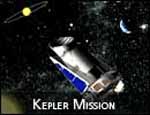
In March, the Kepler Mission was launched with the express goal
of finding Earth-like planets around other stars. It is designed to
find small planets by watching stars closely to see if they suddenly
get dimmer, indicating that something has passed in front of them. For
an Earth-sized planet, that would mean the star becoming dimmer by just
0.01 per cent.
The Wow! Signal and Radio source SHGb02+14a

In 1977, an astronomer with SETI spotted an unusual radio signal
while working on a radio telescope at Ohio State University. He was so
excited by it that he wrote "Wow!" in the margin of the printout.
However, it was never spotted again. After he had calmed down, the
discoverer Dr Jerry R Ehman said he believed it was "an Earth-sourced
signal that simply got reflected off a piece of space debris. "Another
candidate for evidence of alien life was SHGb02+14a, a signal spotted three times in March 2003. It was at a frequency
expected to be used by extraterrestrials  the frequency at which
hydrogen absorbs and emits photons. However, again there were reasons
to be sceptical, not least that it came from a direction in which there
are no stars for 1000 light years. While impossible to rule out
extraterrestrial origin, it may have been a distorted signal from a
pulsar, or just random noise.
SETI@home
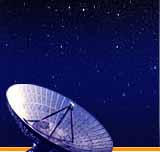
In the 21st century the search for extraterrestrial life
continues in hundreds of thousands of bedrooms and offices around the
world. Launched in 1999, SETI@home is the name given to a virtual
supercomputer made of huge numbers of internet-linked home computers.
Anybody can download the software and allow SETI to use their spare
processing power to scour data from radio telescopes for evidence of
alien intelligence. In terms of power it is the fourth most powerful
computer on the planet. It was this network of home computers that
spotted SHGb02+14a, and one NASA scientist has predicted that it will
find an alien signal by 2025.
Â
NIGHT LIGHTS: Last night, the sun set but the sky did not grow dark. A pair of
bright lights continued to illuminate the heavens:
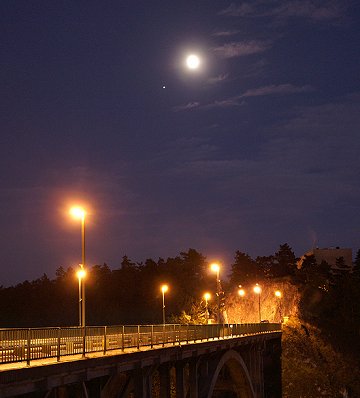
"It was the Moon and Jupiter very close together," says
photographer Monika Landy-Gyebnar of Veszprém, Hungary. "The
beautiful pair twinkled brightly above our town's viaduct, no matter
how the streetlights tried to overshine them."
The scene was repeated in evening skies around the world (see the
images below). Did you miss it? It will happen again on Oct. 26th.
Reminder calls are available from Spaceweather
PHONE.
Coronal Holes:
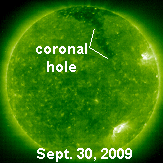
A solar wind stream flowing from the indicated
coronal hole should reach Earth on or about Oct. 2nd. Credit: SOHO Extreme
UV Telescope
https://spaceweather.com/
Â
Hubble Sees Galaxies Stripped by Ram Pressure
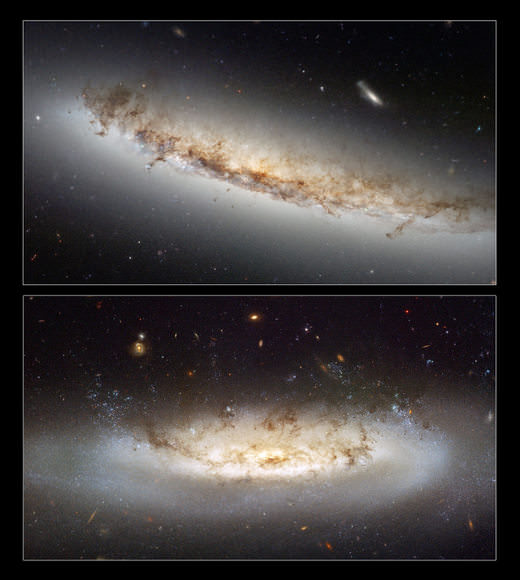
Strange forces of nature are stripping away gas from galaxies in the Virgo cluster.
An extremely hot X-ray emitting gas known as the intra-cluster medium
permeates the regions between galaxies inside clusters and, as fast
moving galaxies whip through this medium, strong winds tear through
galaxies distorting their shape and even halting formation with a process known as "ram pressure stripping." Hubble spied two galaxies "losing it" to these forces.
NASA's Version of Star Trek Replicator Ready for On Orbit Test

It's not quite like requesting "Tea, Earl Grey, hot" and having a
steaming drink appear, but almost. The Electron Beam Freeform
Fabrication, developed at NASA's Langley Research Center, is an
engineer's version of the science fiction replicator on Star Trek. "You
start with a drawing of the part you want to build, you push a button,
and out comes the part," said Karen Taminger, the technology lead for
NASA's Fundamental Aeronautics Program.
Click to continue…

Carnival of Space is hosted by Stuart Atkinson over at Cumbrian Skythe Moon" image above, and who gives Universe Today a very nice plug!
https://www.universetoday.com/
Â
Â


